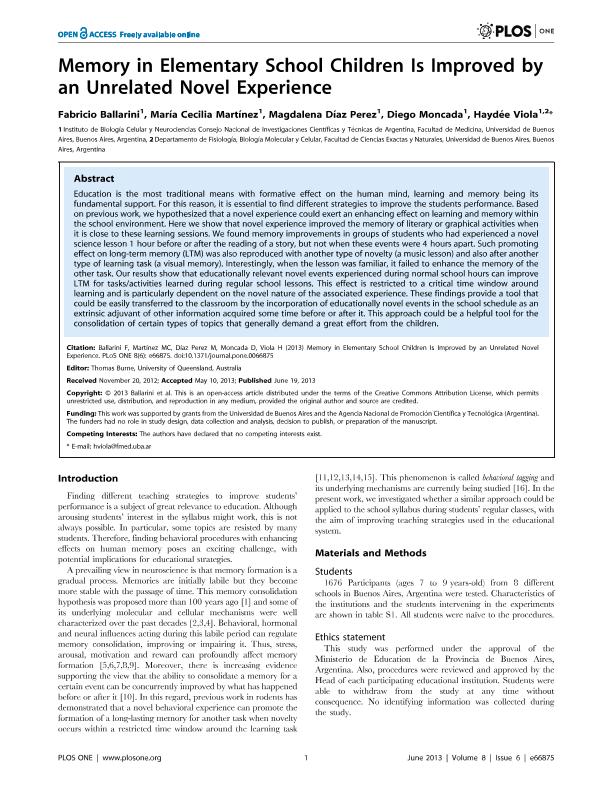Mostrar el registro sencillo del ítem
dc.contributor.author
Ballarini, Fabricio Matias

dc.contributor.author
Martínez, María Cecilia

dc.contributor.author
Díaz Pérez, Magdalena

dc.contributor.author
Moncada, Diego

dc.contributor.author
Viola, Haydee Ana Maria

dc.date.available
2017-05-31T16:50:18Z
dc.date.issued
2013-06
dc.identifier.citation
Ballarini, Fabricio Matias; Martínez, María Cecilia; Díaz Pérez, Magdalena; Moncada, Diego; Viola, Haydee Ana Maria; Memory in elementary school children is improved by an unrelated novel experience; Public Library Of Science; Plos One; 8; 6; 6-2013; e66875
dc.identifier.issn
1932-6203
dc.identifier.uri
http://hdl.handle.net/11336/17158
dc.description.abstract
Education is the most traditional means with formative effect on the human mind, learning and memory being its fundamental support. For this reason, it is essential to find different strategies to improve the studentś performance. Based on previous work, we hypothesized that a novel experience could exert an enhancing effect on learning and memory within the school environment. Here we show that novel experience improved the memory of literary or graphical activities when it is close to these learning sessions. We found memory improvements in groups of students who had experienced a novel science lesson 1 hour before or after the reading of a story, but not when these events were 4 hours apart. Such promoting effect on long-term memory (LTM) was also reproduced with another type of novelty (a music lesson) and also after another type of learning task (a visual memory). Interestingly, when the lesson was familiar, it failed to enhance the memory of the other task. Our results show that educationally relevant novel events experienced during normal school hours can improve LTM for tasks/activities learned during regular school lessons. This effect is restricted to a critical time window around learning and is particularly dependent on the novel nature of the associated experience. These findings provide a tool that could be easily transferred to the classroom by the incorporation of educationally novel events in the school schedule as an extrinsic adjuvant of other information acquired some time before or after it. This approach could be a helpful tool for the consolidation of certain types of topics that generally demand a great effort from the children.
dc.format
application/pdf
dc.language.iso
eng
dc.publisher
Public Library Of Science

dc.rights
info:eu-repo/semantics/openAccess
dc.rights.uri
https://creativecommons.org/licenses/by-nc-sa/2.5/ar/
dc.subject
Behavioral Tagging
dc.subject
Humans
dc.subject
Novelty
dc.subject
Learning
dc.subject.classification
Neurociencias

dc.subject.classification
Medicina Básica

dc.subject.classification
CIENCIAS MÉDICAS Y DE LA SALUD

dc.title
Memory in elementary school children is improved by an unrelated novel experience
dc.type
info:eu-repo/semantics/article
dc.type
info:ar-repo/semantics/artículo
dc.type
info:eu-repo/semantics/publishedVersion
dc.date.updated
2017-05-29T15:36:02Z
dc.journal.volume
8
dc.journal.number
6
dc.journal.pagination
e66875
dc.journal.pais
Estados Unidos

dc.journal.ciudad
San Francisco
dc.description.fil
Fil: Ballarini, Fabricio Matias. Consejo Nacional de Investigaciones Científicas y Técnicas. Oficina de Coordinación Administrativa Houssay. Instituto de Biología Celular y Neurociencia "Prof. Eduardo de Robertis". Universidad de Buenos Aires. Facultad de Medicina. Instituto de Biología Celular y Neurociencia; Argentina
dc.description.fil
Fil: Martínez, María Cecilia. Consejo Nacional de Investigaciones Científicas y Técnicas. Oficina de Coordinación Administrativa Houssay. Instituto de Biología Celular y Neurociencia "Prof. Eduardo de Robertis". Universidad de Buenos Aires. Facultad de Medicina. Instituto de Biología Celular y Neurociencia; Argentina
dc.description.fil
Fil: Díaz Pérez, Magdalena. Consejo Nacional de Investigaciones Científicas y Técnicas. Oficina de Coordinación Administrativa Houssay. Instituto de Biología Celular y Neurociencia "Prof. Eduardo de Robertis". Universidad de Buenos Aires. Facultad de Medicina. Instituto de Biología Celular y Neurociencia; Argentina
dc.description.fil
Fil: Moncada, Diego. Consejo Nacional de Investigaciones Científicas y Técnicas. Oficina de Coordinación Administrativa Houssay. Instituto de Biología Celular y Neurociencia "Prof. Eduardo de Robertis". Universidad de Buenos Aires. Facultad de Medicina. Instituto de Biología Celular y Neurociencia; Argentina
dc.description.fil
Fil: Viola, Haydee Ana Maria. Universidad de Buenos Aires. Facultad de Ciencias Exactas y Naturales. Departamento de Fisiología, Biología Molecular y Celular; Argentina. Consejo Nacional de Investigaciones Científicas y Técnicas. Oficina de Coordinación Administrativa Houssay. Instituto de Biología Celular y Neurociencia "Prof. Eduardo de Robertis". Universidad de Buenos Aires. Facultad de Medicina. Instituto de Biología Celular y Neurociencia; Argentina
dc.journal.title
Plos One

dc.relation.alternativeid
info:eu-repo/semantics/altIdentifier/url/http://journals.plos.org/plosone/article?id=10.1371/journal.pone.0066875
dc.relation.alternativeid
info:eu-repo/semantics/altIdentifier/doi/http://dx.doi.org/10.1371/journal.pone.0066875
Archivos asociados
